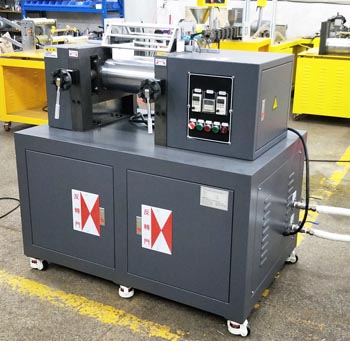A laboratory open mixing mill is an essential tool in polymer science, enabling researchers and manufacturers to develop, test, and optimize polymer formulations. This equipment is a small laboratory mixing equipment specially used to mix and knead elastomeric and thermoplastic rubber,PVC ,polymer samples mixtures .
By providing controlled mixing, precise temperature management, and efficient dispersion of additives, these laboratory mixing machines help ensure the quality and performance of polymer-based products.
These laboratory mixing mill equipment are widely used in R&D laboratories for material formulation, quality testing, and small-scale production trials.
The lab two roll open mixing mill has two horizontally positioned, counter-rotating that can rotate in opposite direction towards each other at different speeds .
When the material is fed to the roll nip gap between the two rolls , it is pulled into the nip between the two rolls due to the friction and adhesion between the material and the roller suface .
With the desired temperature, nip gap and friction, the materials are mixed in the nip of two rolls that generate intense shear and compression forces to blend and refine the materials. The friction and pressure cause the polymer to soften and blend with other ingredients, ensuring uniform dispersion. After several roll ,the material turns to form a homogeneous mass.
In polymer research and development, laboratory open mixing mills play a crucial role in processing and testing materials before large-scale production. These open mxing mill machines help mix, refine, and prepare polymer compounds for further applications.
Basically ,the gap between the rolls can be adjusted ,so that control the thickness of the polymer sheet. A smaller gap increases shear force and improves mixing, while a wider gap allows for gentle processing.
For most laboratory open mixing mill equipment,they have a temperature control system ,which can regulate the heat generated during processing. Proper temperature management helps to improve the mixing efficiency and prevents material degradation.
On the process , in order to ensure thorough mixing and uniformity Operators use a knife or spatula to cut and fold the compound material repeatedly .This process continues until the polymer reaches the desired consistency and dispersion. Once the mixing process is complete, the polymer material is sheeted off the mill and collected for further testing or processing. The final material can be used for molding, extrusion, or additional refining.
Main Benefits of a Laboratory Open Mixing Mill Equipment :
* Precise Control: Adjustable speed, temperature, and roll gap allow for fine-tuning of mixing conditions.
* Uniform Mixing: Ensures even distribution of fillers, additives, and pigments in the polymer matrix.
* Versatility: Suitable for various polymer types, including rubber, silicone, and thermoplastics.
* Small-Scale Efficiency: Ideal for research, formulation development, and quality testing before large-scale production.
Wide Applications of Laboratory Open Mixing Mills
* Material R&D: Developing new polymer formulations and testing ingredient compatibility.
* Quality Control: Evaluating the consistency and performance of polymer batches.
* Pilot Production: Producing small batches for prototype testing before mass production.
* Education and Training: Used in academic and research institutions for polymer processing studies.
Discover how an open two-roll mill can optimize your material mixing process— talk with our experts today!







